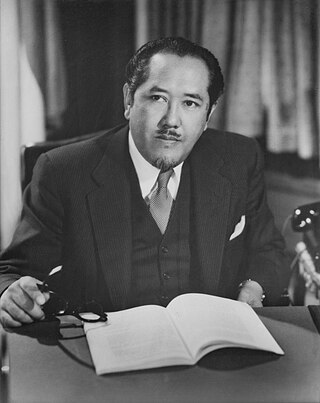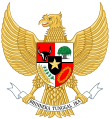
The Indonesian National Party was the name used by several nationalist political parties in Indonesia from 1927 until 1973. The first PNI was established by future President Sukarno. After independence, the new PNI supplied a number of prime ministers, and participated in the majority of cabinets in the 1950s and 1960s. The party was fused into the Indonesian Democratic Party in 1973. In the years following the reforms of the late 1990s, a number of parties claiming to be the continuation of previous PNIs stood in elections, but gained only a handful of seats.

The Prime Minister of the Republic of Indonesia was a political office in Indonesia which existed from 1945 until 1966. During this period, the prime minister was in charge of the cabinet of Indonesia, one of the three branches of government along with the House of Representatives and the president. Following his 1959 decree, President Sukarno assumed the role and powers of prime minister until his resignation in 1966.

The Second Revised Dwikora Cabinet was the Indonesian cabinet which served under President Sukarno from March 1966 until July 1966. The cabinet was formed after Lieutenant General Suharto, using the powers that Sukarno gave to him through Supersemar, arrested 15 ministers from the Revised Dwikora Cabinet who were suspected of being sympathizers of the Indonesian Communist Party (PKI).

The Revised Dwikora Cabinet was the Indonesian cabinet which served under President Sukarno from February 1966 to March 1966. The cabinet was formed under an extremely tense political situation, and it was expected that this cabinet would address the concerns of the people. It was during a meeting of this cabinet that unidentified troops surrounded the Presidential Palace causing to Sukarno to escape to Bogor from where he gave Supersemar to Lieutenant General Suharto.

The Central Indonesian National Committee, also known as the Central National Committee, was a body appointed to assist the president of the newly independent Indonesia. Originally purely advisory, it later gained assumed legislative functions. The Working Committee of the KNIP became part of the People's Representative Council when Indonesia became a unitary state in 1950.

Ali Sastroamidjojo was an Indonesian politician and diplomat. He served in various political and diplomatic roles during the presidency of Sukarno, most notably as a cabinet minister, prime minister, chairman of the Indonesian National Party (PNI), and permanent representative to the United Nations. Ali was born in Grabag, Purworejo, Dutch East Indies, to an aristocratic family from Magelang and studied at Leiden University. During his studies, he was active in several youth organizations, including the Jong Java and the Perhimpoenan Indonesia associations. He was briefly arrested by the Dutch in 1927 but was released shortly thereafter.

The Third Sjahrir Cabinet was the fourth Indonesian cabinet. It served from October 1946 to July 1947, when it fell due to disagreements related to the implementation of the Linggadjati Agreement and subsequent negotiations with the Dutch.

The First Amir Sjarifuddin Cabinet was the fifth Indonesian cabinet and was in office from 3 July to 11 November 1947.

The Second Amir Sjarifuddin Cabinet was Indonesia's sixth cabinet and was the result of a reshuffle to allow for the entry of the Masyumi Party, which gained five posts. The cabinet lasted only two months and eleven days, from 11 November 1947 to 29 January 1948, after Masyumi withdrew its ministers in protest at the Renville Agreement the government signed with the Dutch.

The First Hatta Cabinet was Indonesia's seventh cabinet. It was formed by Vice President Mohammad Hatta, who was instructed to do so by President Sukarno on 23 January 1948, the same day the previous cabinet was declared dissolved. Following the second Dutch military aggression, when the republican capital of Yogyakarta was seized and most of the cabinet arrested, much of the cabinet was captured and sent into exile, although it was not formally disbanded. After the political leadership returned effective 13 July 1949 the cabinet continued its mandate until it was reshuffled on 4 August.

The Dwikora Cabinet was the 23rd Indonesian cabinet. President Sukarno reshuffled the previous cabinet on 27 August 1964 to produce a cabinet better able to implement the government policy he had announced in his Independence Day speech entitled "The Year of Living Dangerously". The cabinet was appointed on 2 September and served for a year and five months before being reshuffled on 21 February 1966.

Major general TNI (Tit.) Dr. Adnan Kapau Gani or commonly abbreviated as A.K. Gani was an Indonesian doctor, politician, actor and military figure. He served as Deputy Prime Minister in the Cabinet of Amir Sjarifuddin I and the Cabinet of Amir Sjarifuddin II.

Herling Laoh was an Indonesian bureaucrat and engineer. A member of the Indonesian National Party (PNI), Laoh served as minister of public works (1947–1950) and minister of transportation (1949–1950). Born to a goldsmith and his wife in present-day North Sulawesi, he studied civil engineering at the Technische Hoogeschool te Bandoeng (THB). After graduating in 1928, he worked as an engineer in various construction projects. Following the Proclamation of Indonesian Independence in 1945, he joined the PNI and served as a minister in several cabinets. He was later involved in PRRI/Permesta rebellion, becoming a state minister in the rebel government.

Union of Islamic Education, also known as PERTI, is a Shafii-Ash'ari Islamic organization in Indonesia. The organization was founded by Sulaiman ar-Rasuli on May 5, 1928 in Candung, West Sumatra. In its development, PERTI had become a political party and gained four People's Representative Council (DPR-RI) seats and seven Constituent seats in 1955 general election.

Arudji Kartawinata was an Indonesian politician and military officer. During the Indonesian National Revolution, he was the first commander of the 3rd Division, predecessor to the modern Siliwangi Division. Politically, he was initially a member of Masyumi before later re-forming the Indonesian Islamic Union Party. He served as the chairman of the People's Representative Council for three years between 1963 and 1966.

Setiadi Reksoprodjo was an Indonesian politician who served as Minister of Information in First Amir Sjarifuddin Cabinet, Junior Minister of Information in Second Amir Sjarifuddin Cabinet, member of the People's Consultative Assembly and the Constitutional Assembly, and as the Minister of Electricity and Energy in Dwikora Cabinet and Revised Dwikora Cabinet. Setiadi was 25 years and 7 months old when he was appointed as Minister of Information, making him the youngest minister in Indonesia up to this day.

National Cyber and Crypto Agency, is Indonesia's primary signal intelligence agency, as well as cyber intelligence, cyber threat intelligence, cyber defense, and cyber security agency.

Rusiah Sardjono was an Indonesian politician who served as minister of social affairs from 1962 to 1966. She was one of the country's first female government ministers.








































